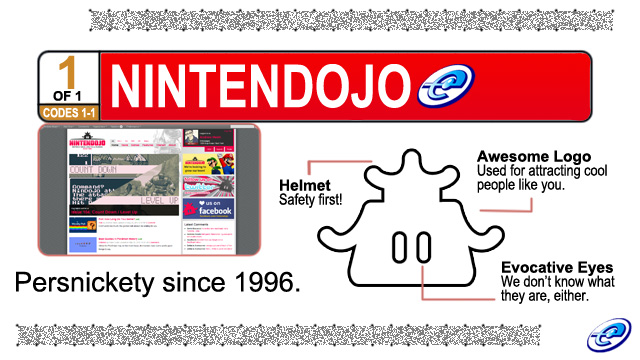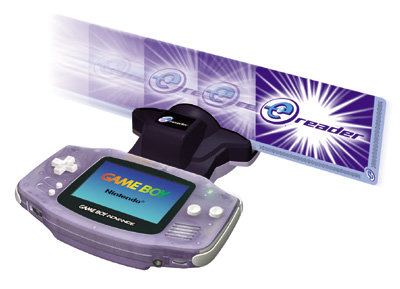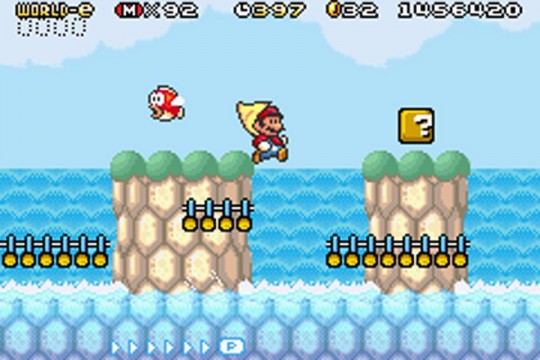
Much has been made of the fact that Fire Emblem: Awakening will be the first Nintendo game to support paid downloadable content, a move which many consider to be long overdue given the current state of the games industry. While it’s certainly nice to see the company finally embracing the digital movement in earnest, the truth is this is not the first time it has experimented with the idea. Notwithstanding the fact that Animal Crossing: City Folk and the DS Pokémon titles have all received off-disc extras for free through Nintendo’s own Wi-Fi service, Nintendo has actually offered paid add-on content for many of its games long before DLC became an industry standard (or, indeed, before the company even took its first grudging steps into the online sphere), and it did so using the very thing that had sustained it for nearly a century of its existence– playing cards.
Released in North America in September 2002, the e-Reader, an add-on device that plugged into the Game Boy Advance’s cartridge slot, allowed gamers to scan specially-made cards for use in certain titles. These cards, typically signified by a gold or silver strip running along their border, contained a piece of code that would activate a unique item in the corresponding game. The content of these cards ranged from special furniture for Animal Crossing to standalone mini-games to even complete NES titles (albeit simpler ones like Balloon Fight and Donkey Kong), providing gamers with a surprisingly robust array of content to enjoy (especially considering the rather limited technology that powered the device).

What’s particularly interesting about the e-Reader and its functionality is just how closely it mirrors modern-day DLC. Beyond offering a way to repurchase certain NES titles that have long been out of print (a clear precursor to Wii’s Virtual Console service), the device was also conceived as a way to extend the longevity of modern games by providing them with supplementary content. Pokémon Ruby and Sapphire flirted with this idea by offering new trainers for the player to battle after completing the story (as well as special items that would unlock certain Pokémon), but the vast majority of games only used the e-Reader in an ancillary fashion. Outside of the aforementioned Pokémon titles (and one other notable exception that I will touch upon below), GameCube’s Animal Crossing was the only other game to really make use of the device. Players could purchase special packs of Animal Crossing-e cards that would contain an assortment of different items they could upload to their towns. These ranged from special town tunes and clothing patterns to rare pieces of furniture and even letters from other animals, making them a neat, if unnecessary, bonus for fans of the game who just so happened to also own an e-Reader and a Game Boy Advance.
Of course, while these titles laid down the foundation for the e-Reader’s capabilities, the most promising use of the device came from none other than Super Mario Advance 4. Like the SNES remake upon which it was based, Super Mario Advance 4 was primarily a gussied up version of Super Mario Bros. 3 with a few extra features thrown in for good measure. The most prominent of these was e-Reader support, and the game made extensive use of its functionality by offering entire new levels for the player to conquer. While that alone would have been enough to whet the appetite of any Mario fan, the majority of these levels culled together various elements from the plumber’s other games into their design, making them a veritable “greatest hits” compilation of the Mario series. It was not unusual to see the vegetables from Super Mario Bros. 2 crop up in a stage populated by enemies from Super Mario World, and some e-Reader-exclusive items (like throwable boomerangs) would even go on to inspire power-ups in future Mario games.
In retrospect, it’s a little surreal to think that Nintendo had once offered additional levels for one of its most popular Mario titles long before the concept of DLC was even introduced to the industry, but that was precisely the kind of thing the e-Reader allowed. By all accounts, this should have boded well for the company’s enthusiasm for add-on content, but the device’s untimely failure, coupled with the developer’s initial resistance to the online movement, ultimately stunted its willingness to adopt the practice.

It certainly didn’t help that the e-Reader’s bulky size made it impractical to carry around, nor did the finicky nature of its card scanner make it particularly easy to use, turning the device into a curiosity more akin to the Virtual Boy than a vital piece of technology. While these in themselves were significant hurdles for the e-Reader to overcome, most damning of all was the fact that it had to be plugged into the Game Boy Advance’s cartridge slot in order to function, effectively limiting the number of games that it could interact with. Any GameCube titles that supported the device were largely unaffected thanks to the GC-GBA link cable, but its reliance on the Game Boy Advance meant that it could not interact with most of the handheld’s own games. Any titles that did support the device, like Super Mario Advance 4 (the game that, ironically enough, made the most compelling use of it by offering entire new levels to play), were only capable of receiving this extra data provided you had a second Game Boy Advance (and a Game Boy Advance link cable) lying around, which meant that the vast majority of fans could not even experience the additional content that was created for these games. It also didn’t help that add-on devices have always had a history of failure outside of Japan’s eccentric boarders, making the e-Reader’s eventual demise, less than two years after it was released, a foregone conclusion.
Still, the e-Reader’s unique vision made it one of the most innovative products to ever hit the market, and it’s safe to say the device helped pave the way for what would eventually become downloadable content. In a sense, this puts it in the same pantheon (at least conceptually) as Nintendo’s own Satellaview. Like the Super Famicom add-on, the e-Reader experimented with a concept that was far beyond its time, introducing ideas that would not take root in the industry until years after its discontinuation. While its muted reception may have made the device an obscure footnote in Nintendo’s long history, the e-Reader’s unique influence was much further reaching than it may initially appear.




 ShareThis
ShareThis







Wow i didnt remember this thing, Nintendo is always ahead of their time, but it looks like some of their ideas take some time to adjust to the market.
Too true! Makes you wonder which of their other failed experiments will reappear in the future…
Oh man, I remember the e-Reader. I loved the concept, and I still have a bunch of the cards from various games and promotions lying around.
I bought both series of Mario eCards when they were released for the extra levels, and I loved them, but I remember every time I went to Walmart for months afterward looking for series 3 and 4 and never finding them. I still wish there had been a way to get them. Some players have managed to hack the rom to play the other levels and they look pretty cool.
I’m sad to say I never got to experience the levels myself because I didn’t own a second Game Boy Advance at the time (nor did I have a disposable income, but that’s another matter…), but I’d love to see Nintendo re-release Super Mario Advance 4 on the eShop with all of the e-Reader extras intact. Heck, I think I’d even buy them separately if they were offered as actual DLC. XD